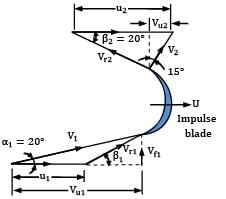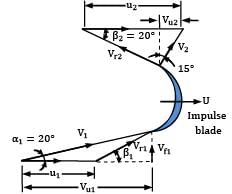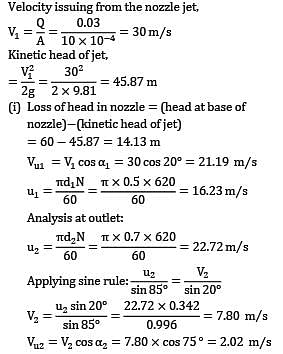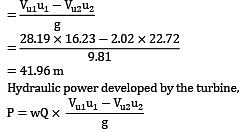Civil Engineering (CE) Exam > Civil Engineering (CE) Questions > An outward radial flow impulse turbine has n...
Start Learning for Free
An outward radial flow impulse turbine has nozzles with a total area of 10 cm2 . The guide vanes make an angle of 20° to the wheel tangent at exit. The inner and outer diameters are 0.5 m and 0.7 m respectively. The moving vanes have an outlet angle of 20° to the wheel tangent. The turbine develops 11.75 kW at the shaft running at 620 rpm under a head of 60 m, at a discharge of 0.03 m3⁄s. The water at discharge end leaves the runner in a forward direction and is inclined at 15° to the radius. Calculate
(i) the head lost in the nozzle
(ii) the head lost by the bearing friction

- a)14.13 m and 2.04 m respectively
- b)1.4 m and 2.04 m respectively
- c)1.4 m and 0.2 m respectively
- d)14.13 m and 0.2 m respectively
Correct answer is option 'A'. Can you explain this answer?
Verified Answer
An outward radial flow impulse turbine has nozzles with a total area ...
Refer to Fig. in question for nomenclature and vector diagrams.


View all questions of this test
Analysis at inlet:


Work done (or head utilized) per unit of weight of water

= 9810 × 0.03 × 41.96 = 12350 W
= 12.35 kW
(ii) Power lost due to friction at the bearings = water power − brake power
= 12.35 − 11.75 = 0.60 kW If hf is the head loss in bearing,
then 0.60 × 103
= 9810 × 0.03 × hf ;
hf ≈ 2.04 m
Most Upvoted Answer
An outward radial flow impulse turbine has nozzles with a total area ...
Refer to Fig. in question for nomenclature and vector diagrams.


Analysis at inlet:


Work done (or head utilized) per unit of weight of water

= 9810 × 0.03 × 41.96 = 12350 W
= 12.35 kW
(ii) Power lost due to friction at the bearings = water power − brake power
= 12.35 − 11.75 = 0.60 kW If hf is the head loss in bearing,
then 0.60 × 103
= 9810 × 0.03 × hf ;
hf ≈ 2.04 m

|
Explore Courses for Civil Engineering (CE) exam
|

|
Similar Civil Engineering (CE) Doubts
An outward radial flow impulse turbine has nozzles with a total area of 10 cm2 . The guide vanes make an angle of 20° to the wheel tangent at exit. The inner and outer diameters are 0.5 m and 0.7 m respectively. The moving vanes have an outlet angle of 20° to the wheel tangent. The turbine develops 11.75 kW at the shaft running at 620 rpm under a head of 60 m, at a discharge of 0.03 m3⁄s. The water at discharge end leaves the runner in a forward direction and is inclined at 15° to the radius. Calculate(i) the head lost in the nozzle(ii) the head lost by the bearing frictiona) 14.13 m and 2.04 m respectivelyb) 1.4 m and 2.04 m respectivelyc) 1.4 m and 0.2 m respectivelyd) 14.13 m and 0.2 m respectivelyCorrect answer is option 'A'. Can you explain this answer?
Question Description
An outward radial flow impulse turbine has nozzles with a total area of 10 cm2 . The guide vanes make an angle of 20° to the wheel tangent at exit. The inner and outer diameters are 0.5 m and 0.7 m respectively. The moving vanes have an outlet angle of 20° to the wheel tangent. The turbine develops 11.75 kW at the shaft running at 620 rpm under a head of 60 m, at a discharge of 0.03 m3⁄s. The water at discharge end leaves the runner in a forward direction and is inclined at 15° to the radius. Calculate(i) the head lost in the nozzle(ii) the head lost by the bearing frictiona) 14.13 m and 2.04 m respectivelyb) 1.4 m and 2.04 m respectivelyc) 1.4 m and 0.2 m respectivelyd) 14.13 m and 0.2 m respectivelyCorrect answer is option 'A'. Can you explain this answer? for Civil Engineering (CE) 2025 is part of Civil Engineering (CE) preparation. The Question and answers have been prepared according to the Civil Engineering (CE) exam syllabus. Information about An outward radial flow impulse turbine has nozzles with a total area of 10 cm2 . The guide vanes make an angle of 20° to the wheel tangent at exit. The inner and outer diameters are 0.5 m and 0.7 m respectively. The moving vanes have an outlet angle of 20° to the wheel tangent. The turbine develops 11.75 kW at the shaft running at 620 rpm under a head of 60 m, at a discharge of 0.03 m3⁄s. The water at discharge end leaves the runner in a forward direction and is inclined at 15° to the radius. Calculate(i) the head lost in the nozzle(ii) the head lost by the bearing frictiona) 14.13 m and 2.04 m respectivelyb) 1.4 m and 2.04 m respectivelyc) 1.4 m and 0.2 m respectivelyd) 14.13 m and 0.2 m respectivelyCorrect answer is option 'A'. Can you explain this answer? covers all topics & solutions for Civil Engineering (CE) 2025 Exam. Find important definitions, questions, meanings, examples, exercises and tests below for An outward radial flow impulse turbine has nozzles with a total area of 10 cm2 . The guide vanes make an angle of 20° to the wheel tangent at exit. The inner and outer diameters are 0.5 m and 0.7 m respectively. The moving vanes have an outlet angle of 20° to the wheel tangent. The turbine develops 11.75 kW at the shaft running at 620 rpm under a head of 60 m, at a discharge of 0.03 m3⁄s. The water at discharge end leaves the runner in a forward direction and is inclined at 15° to the radius. Calculate(i) the head lost in the nozzle(ii) the head lost by the bearing frictiona) 14.13 m and 2.04 m respectivelyb) 1.4 m and 2.04 m respectivelyc) 1.4 m and 0.2 m respectivelyd) 14.13 m and 0.2 m respectivelyCorrect answer is option 'A'. Can you explain this answer?.
An outward radial flow impulse turbine has nozzles with a total area of 10 cm2 . The guide vanes make an angle of 20° to the wheel tangent at exit. The inner and outer diameters are 0.5 m and 0.7 m respectively. The moving vanes have an outlet angle of 20° to the wheel tangent. The turbine develops 11.75 kW at the shaft running at 620 rpm under a head of 60 m, at a discharge of 0.03 m3⁄s. The water at discharge end leaves the runner in a forward direction and is inclined at 15° to the radius. Calculate(i) the head lost in the nozzle(ii) the head lost by the bearing frictiona) 14.13 m and 2.04 m respectivelyb) 1.4 m and 2.04 m respectivelyc) 1.4 m and 0.2 m respectivelyd) 14.13 m and 0.2 m respectivelyCorrect answer is option 'A'. Can you explain this answer? for Civil Engineering (CE) 2025 is part of Civil Engineering (CE) preparation. The Question and answers have been prepared according to the Civil Engineering (CE) exam syllabus. Information about An outward radial flow impulse turbine has nozzles with a total area of 10 cm2 . The guide vanes make an angle of 20° to the wheel tangent at exit. The inner and outer diameters are 0.5 m and 0.7 m respectively. The moving vanes have an outlet angle of 20° to the wheel tangent. The turbine develops 11.75 kW at the shaft running at 620 rpm under a head of 60 m, at a discharge of 0.03 m3⁄s. The water at discharge end leaves the runner in a forward direction and is inclined at 15° to the radius. Calculate(i) the head lost in the nozzle(ii) the head lost by the bearing frictiona) 14.13 m and 2.04 m respectivelyb) 1.4 m and 2.04 m respectivelyc) 1.4 m and 0.2 m respectivelyd) 14.13 m and 0.2 m respectivelyCorrect answer is option 'A'. Can you explain this answer? covers all topics & solutions for Civil Engineering (CE) 2025 Exam. Find important definitions, questions, meanings, examples, exercises and tests below for An outward radial flow impulse turbine has nozzles with a total area of 10 cm2 . The guide vanes make an angle of 20° to the wheel tangent at exit. The inner and outer diameters are 0.5 m and 0.7 m respectively. The moving vanes have an outlet angle of 20° to the wheel tangent. The turbine develops 11.75 kW at the shaft running at 620 rpm under a head of 60 m, at a discharge of 0.03 m3⁄s. The water at discharge end leaves the runner in a forward direction and is inclined at 15° to the radius. Calculate(i) the head lost in the nozzle(ii) the head lost by the bearing frictiona) 14.13 m and 2.04 m respectivelyb) 1.4 m and 2.04 m respectivelyc) 1.4 m and 0.2 m respectivelyd) 14.13 m and 0.2 m respectivelyCorrect answer is option 'A'. Can you explain this answer?.
Solutions for An outward radial flow impulse turbine has nozzles with a total area of 10 cm2 . The guide vanes make an angle of 20° to the wheel tangent at exit. The inner and outer diameters are 0.5 m and 0.7 m respectively. The moving vanes have an outlet angle of 20° to the wheel tangent. The turbine develops 11.75 kW at the shaft running at 620 rpm under a head of 60 m, at a discharge of 0.03 m3⁄s. The water at discharge end leaves the runner in a forward direction and is inclined at 15° to the radius. Calculate(i) the head lost in the nozzle(ii) the head lost by the bearing frictiona) 14.13 m and 2.04 m respectivelyb) 1.4 m and 2.04 m respectivelyc) 1.4 m and 0.2 m respectivelyd) 14.13 m and 0.2 m respectivelyCorrect answer is option 'A'. Can you explain this answer? in English & in Hindi are available as part of our courses for Civil Engineering (CE).
Download more important topics, notes, lectures and mock test series for Civil Engineering (CE) Exam by signing up for free.
Here you can find the meaning of An outward radial flow impulse turbine has nozzles with a total area of 10 cm2 . The guide vanes make an angle of 20° to the wheel tangent at exit. The inner and outer diameters are 0.5 m and 0.7 m respectively. The moving vanes have an outlet angle of 20° to the wheel tangent. The turbine develops 11.75 kW at the shaft running at 620 rpm under a head of 60 m, at a discharge of 0.03 m3⁄s. The water at discharge end leaves the runner in a forward direction and is inclined at 15° to the radius. Calculate(i) the head lost in the nozzle(ii) the head lost by the bearing frictiona) 14.13 m and 2.04 m respectivelyb) 1.4 m and 2.04 m respectivelyc) 1.4 m and 0.2 m respectivelyd) 14.13 m and 0.2 m respectivelyCorrect answer is option 'A'. Can you explain this answer? defined & explained in the simplest way possible. Besides giving the explanation of
An outward radial flow impulse turbine has nozzles with a total area of 10 cm2 . The guide vanes make an angle of 20° to the wheel tangent at exit. The inner and outer diameters are 0.5 m and 0.7 m respectively. The moving vanes have an outlet angle of 20° to the wheel tangent. The turbine develops 11.75 kW at the shaft running at 620 rpm under a head of 60 m, at a discharge of 0.03 m3⁄s. The water at discharge end leaves the runner in a forward direction and is inclined at 15° to the radius. Calculate(i) the head lost in the nozzle(ii) the head lost by the bearing frictiona) 14.13 m and 2.04 m respectivelyb) 1.4 m and 2.04 m respectivelyc) 1.4 m and 0.2 m respectivelyd) 14.13 m and 0.2 m respectivelyCorrect answer is option 'A'. Can you explain this answer?, a detailed solution for An outward radial flow impulse turbine has nozzles with a total area of 10 cm2 . The guide vanes make an angle of 20° to the wheel tangent at exit. The inner and outer diameters are 0.5 m and 0.7 m respectively. The moving vanes have an outlet angle of 20° to the wheel tangent. The turbine develops 11.75 kW at the shaft running at 620 rpm under a head of 60 m, at a discharge of 0.03 m3⁄s. The water at discharge end leaves the runner in a forward direction and is inclined at 15° to the radius. Calculate(i) the head lost in the nozzle(ii) the head lost by the bearing frictiona) 14.13 m and 2.04 m respectivelyb) 1.4 m and 2.04 m respectivelyc) 1.4 m and 0.2 m respectivelyd) 14.13 m and 0.2 m respectivelyCorrect answer is option 'A'. Can you explain this answer? has been provided alongside types of An outward radial flow impulse turbine has nozzles with a total area of 10 cm2 . The guide vanes make an angle of 20° to the wheel tangent at exit. The inner and outer diameters are 0.5 m and 0.7 m respectively. The moving vanes have an outlet angle of 20° to the wheel tangent. The turbine develops 11.75 kW at the shaft running at 620 rpm under a head of 60 m, at a discharge of 0.03 m3⁄s. The water at discharge end leaves the runner in a forward direction and is inclined at 15° to the radius. Calculate(i) the head lost in the nozzle(ii) the head lost by the bearing frictiona) 14.13 m and 2.04 m respectivelyb) 1.4 m and 2.04 m respectivelyc) 1.4 m and 0.2 m respectivelyd) 14.13 m and 0.2 m respectivelyCorrect answer is option 'A'. Can you explain this answer? theory, EduRev gives you an
ample number of questions to practice An outward radial flow impulse turbine has nozzles with a total area of 10 cm2 . The guide vanes make an angle of 20° to the wheel tangent at exit. The inner and outer diameters are 0.5 m and 0.7 m respectively. The moving vanes have an outlet angle of 20° to the wheel tangent. The turbine develops 11.75 kW at the shaft running at 620 rpm under a head of 60 m, at a discharge of 0.03 m3⁄s. The water at discharge end leaves the runner in a forward direction and is inclined at 15° to the radius. Calculate(i) the head lost in the nozzle(ii) the head lost by the bearing frictiona) 14.13 m and 2.04 m respectivelyb) 1.4 m and 2.04 m respectivelyc) 1.4 m and 0.2 m respectivelyd) 14.13 m and 0.2 m respectivelyCorrect answer is option 'A'. Can you explain this answer? tests, examples and also practice Civil Engineering (CE) tests.

|
Explore Courses for Civil Engineering (CE) exam
|

|
Signup for Free!
Signup to see your scores go up within 7 days! Learn & Practice with 1000+ FREE Notes, Videos & Tests.


























